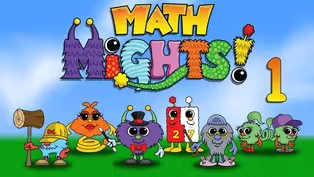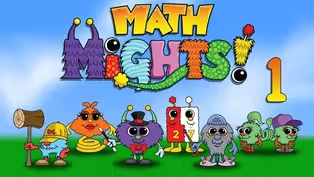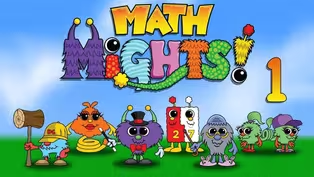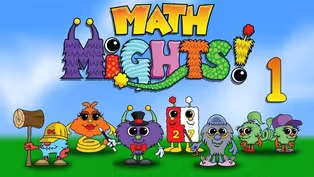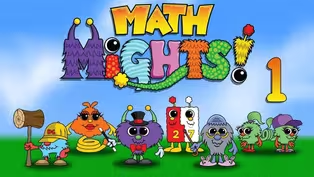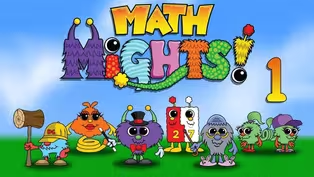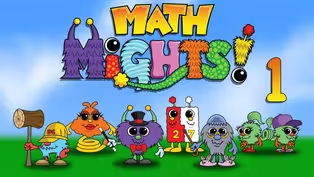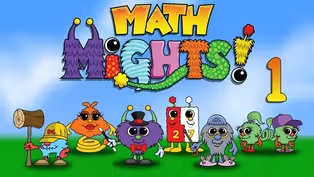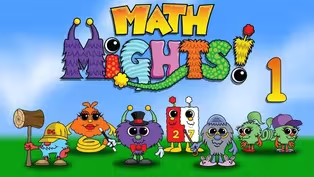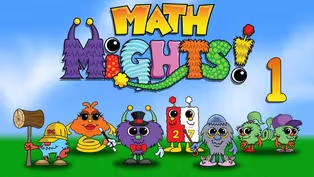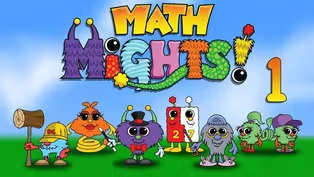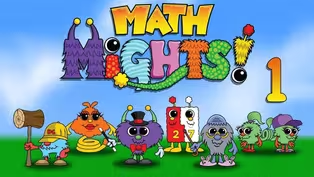Math Mights
Greater Than, Less Than
Season 2 Episode 218 | 16mVideo has Closed Captions
Join Mrs. Markavich & Dotson to talk about numbers with the Counting Buddy Senior!
Join Mrs. Markavich & Dotson to talk about numbers with the Counting Buddy Senior! Let's learn together about "greater than", "less than" and "equal to."
Problems playing video? | Closed Captioning Feedback
Problems playing video? | Closed Captioning Feedback
Math Mights is a local public television program presented by Detroit PBS
Math Mights
Greater Than, Less Than
Season 2 Episode 218 | 16mVideo has Closed Captions
Join Mrs. Markavich & Dotson to talk about numbers with the Counting Buddy Senior! Let's learn together about "greater than", "less than" and "equal to."
Problems playing video? | Closed Captioning Feedback
How to Watch Math Mights
Math Mights is available to stream on pbs.org and the free PBS App, available on iPhone, Apple TV, Android TV, Android smartphones, Amazon Fire TV, Amazon Fire Tablet, Roku, Samsung Smart TV, and Vizio.
Providing Support for PBS.org
Learn Moreabout PBS online sponsorshipMore from This Collection
Video has Closed Captions
Join Mrs. Markavich for a missing addend word problem with Professor Barble! (16m 5s)
Adding Tens-Tens and Ones-Ones
Video has Closed Captions
Join Mrs. Markavich for a missing addend word problem with Professor Barble! (15m 35s)
Write Equations to Match the Strategy
Video has Closed Captions
Join Mrs. Markavich for a missing addend word problem with Professor Barble. (16m 2s)
Video has Closed Captions
Join Mrs. Markavich for a subtraction word problem with Professor Barble. (15m 59s)
Video has Closed Captions
Join Mrs. Markavich for a missing addend word problem. (16m 6s)
Add 2-Digit Numbers & Write Equations
Video has Closed Captions
Join Mrs. Markavich for a word problem with her friend Professor Barble! (15m 59s)
Comparing Numbers Different Ways
Video has Closed Captions
Value Pak shows you the different ways to compare 2-digit numbers. (15m 44s)
Video has Closed Captions
Join Mrs. Markavich for a word problem with her friend Professor Barble! (15m 59s)
Video has Closed Captions
Join Mrs. Markavich for a word problem with her friend Professor Barble! (15m 59s)
Decompose/Compose #'s Different Ways
Video has Closed Captions
We show you different ways to decompose and compose 2-digit numbers! (15m 59s)
Video has Closed Captions
Join Mrs. Markavich & Dotson for a Numeracy Talk with the Counting Buddy Senior (16m)
Video has Closed Captions
Join Mrs. Markavich for Numeracy Talk with Dotson working on conservation to 20. (16m)
Providing Support for PBS.org
Learn Moreabout PBS online sponsorship(happy music) (chimes tinkling) (springs boinging) (feet creak) (slide whistle whistles) (antenna beeping) (glass squeaks) - [Students] Math Mights!
- Hey they're first grade Math Mights.
It's Mrs. Markavich here to talk about all kinds of math with you today.
Let's take a look at our plan for today.
The first thing we'll be doing is a numeracy talk with our friend Dotson.
And then, we'll be talking about greater than, and less than.
Here's my friend Dotson, and he wants us to warm up our math brain.
Here we go, hey Dotson.
It's time for us to head over to that magic red carpet, and our friend the Senior Counting Buddy is back.
And just in case you don't remember from the last time, we're gonna talk about him for a quick minute.
So let's take a look over here.
Here is the Counting Buddy Senior, and he is sitting on my board in a linear fashion.
Mathematicians, the word linear means that it is horizontal.
He is going from left to right on my board.
Remember, he has two different color beads.
He has some red beads, and he has some blue beads, and both sets of beads are a group of 10.
And I'm going to show you really quick, we have one, two, three, four, five, six, seven, eight, nine, 10.
Here is a group of 10.
I also have a group of 10 over here.
I know that I can put the number 10 in my head and count on.
So I'm gonna drag down three more beads, watch me.
10, 11, 12, 13.
I have 13 beads over here.
But then, I have a few left up by his head.
Those are leftover or unused beads.
And I know that if I have 20 beads total and I have 13 beads on the left, I know that there are seven beads that are unused or left over.
So now it's time for you to take what you know, take a picture of what I flash you, hold it there, and then, we're going to talk about it.
Are you ready?
Here we go.
Three, two, one, take a picture.
Hmm, I wonder what you saw.
Did you see that group of 10?
And then, did you see some more?
Did you see any that were left over?
Well, I have three friends, Maggie, Miriam, and Terrell, and they had some ideas of what they saw.
I wonder if you saw what my friends saw.
Maggie said, "I saw 15."
Miriam says, "I saw 16."
And Terrell says, "I saw 16 too."
Let's take a look at our first friend.
My first friend said, "I saw a group of 10 and 5 more."
Do you agree or disagree?
I want to head over to My Counting Buddy Senior.
I know that this is a group of 10, and my friend saw 10, and then, she saw five more so I'm gonna pull down one, two, three, four, five.
And I know that 10 add 5 is 15.
Do you agree with this?
Is this what you saw too?
Hmm, I want to take a look at my second friend and see what they saw, and we're going to compare what both of them saw.
Terrell says, "I politely disagree with Maggie's answer.
I think there were 16, and that 10 and 6 more make 16."
Let's take a look at what our friend Terrell saw.
I know he said that there were 10, and then, he saw six more, count with me, 10, one, two, three, four, five, six.
And I know I can keep counting, 10, 11, 12, 13, 14, 15, 16.
Hmm, Maggie said she saw 15, and Terrell says he saw 16.
Let's take another look at our original picture that we took.
Let's take a really close look at that.
I see 10.
And then, I see six more.
And I know that 10 and 6 make 16.
So this time, my friend Terrell is right.
That's okay that Maggie's not right because she's learning, and it's okay to make mistakes in math.
My friend Maggie says, "Oh, I see it now.
It is 16.
Thanks for showing me a different way to look at this."
All right first grade Math Mights.
Let's take a look at our I can statement of the day.
It says I can compare two-digit numbers using less than, equal, and greater than because I understand tens and ones.
I wonder when I look at this, what do you notice?
What do you wonder?
I see some numbers, and then, I see this little symbol in the middle.
I wonder what that is.
Let's take a look and see if we can talk a little more about that symbol.
When I look at this, I know that the wider part of the symbol points toward the larger number.
And then, that little point is pointing toward the smaller number.
Let's take another look at that.
I want to take a look at my friend Terrell.
He has a thought for us.
He says, "I wonder, is this always true?"
And we can see 78 is less than 45.
And then, it says 78 is greater than 45.
Do you wonder the same thing?
Let's take another look at that.
I am going to ask my friend Allie the alligator to come on up.
She is going to go right in the middle, and she is going to chomp, chomp, chomp that number 78 because I know that 78 is greater than 45.
I'm gonna ask my friend Allie to step out for just a minute, and I'm going to let my friend Al come up.
Al's going to come in here, and remember, our mouth is always open toward the greater number.
So when I look at this and I look at 78 and 45, I have to stop and think hmm, I don't think that 45 is greater than 78.
So I don't think that this can be true.
My friend Al can't chomp the 45 because 45 is not greater than 78.
So my friend Terrell is saying," Hmm, is this always true?"
No, it's not always true.
And this is where it's important to take a look at the order of the numbers because the order of the numbers does matter.
We can take Terrell's thought and make that a true statement, and it will look like this.
If I want my friend Al to chomp the bigger number, I'm going to switch these two numbers like this.
I'm going to put the smaller number in front like that, 45, and I'm going to put 78 on this side.
And this is going to say 45 is less than 78.
So what I really want you to remember is that the order of the numbers matters as well as the way that you write the comparison.
Those are two really important things when we're comparing numbers.
Now let's take a look at another example.
Which one is correct?
34 is greater than 54, or 54 is greater than 34?
Hmm, both of those equations have the same numbers.
They both have a 34, and they both have a 54.
But in one of them, it's saying 34 is greater, and in the other one, it is saying that the 54 is greater.
My friend Maggie has a thought.
She says, "54 is greater than 34 is correct.
The wider part is open to the 54, which is larger."
Let's take a look at that.
I have it here in front of me.
I have two different ways, and I have my friends Al and Allie to help us solve this.
So my friend Al is chomping the top numbers where it says 34 is greater than 54.
Hmm, does that look right?
I think we need to take a closer look at that and look at our tens and our ones.
When I pull it apart, I see that both numbers have the same amount of ones.
But then when I look closer at the tens, I see that there is a 30 on this side and a 50 on this side, and I know that 50 is greater than 30.
So when I put these back together and I have 34 and 54, I don't think that 34 is bigger than 54 but just to check my work, because good mathematicians always check their work, I'm gonna look at my bottom example.
And down here, I have my friend Allie.
I have the number 54, and I have the number 34, and they actually are in different places than they were on the top.
This time the 54 is first, and the 34 is second, and my friend Allie wants to chomp, chomp, chomp that 54.
And I'm gonna pull it apart just like I did on top and take a closer look.
On this side, I have a 50, and I have a 30.
Again, I have the same amount of ones, four ones over here and four ones over here.
When I slide them back together just like this, I know that 54 is greater than 34.
So Allie is going to chomp, chomp, chomp the 54.
And that tells me, when I look back up here, my friend Al is not right.
And so I think that my friend Maggie is correct.
54 is greater than 34.
Great job, Maggie.
First grade Math Mights, you're getting really good at greater than, less than and equal to, so now I think it's time for us to play a game.
We're going to play a game called true and false.
Before we start that game, let's talk about the words true and false.
I'll give you a couple of examples.
Here we go.
My hair is blue.
Is that true or false?
That's false because I don't have blue hair.
I have lots of old lady gray hair.
Let's talk about the word true.
I'm wearing glasses.
That's true.
Now it's your turn to think about numbers and whether this equation is true or false.
Here's my first one.
17 is less than 47.
Think about it.
Grab that answer and now let's talk about it.
I have the numbers 17 and 47.
My equation said 17 is less than 47, so I'm going to grab my friend Al the alligator and put him in the middle, and let's take a look at this.
Is this true, or is this false?
I have 17 is less than 47.
I have the same amount of ones, so I'm gonna look at my tens.
On this side, I only have one 10 which makes the number 17.
But on this side, I have four tens which makes the number 47.
And I know that 17 is less than 47.
So if you said that this statement is true, I want you to kiss your brain.
(smacks lips) Let's take a look at another one.
My next example says 58 equals 53.
I want to know is this true, or is this false?
I want you to really think about it.
Let's take a really close look at this.
I have in front of me 53 equals 58.
Hmm, I know that equal numbers mean that they would be the same on both sides.
So when I look at this and I see they both have 5 tens, but when I take a closer look at the ones, this side only has three ones, and this side has eight ones, so I know that this is false.
I wonder, did you say that this was false?
I think you're so smart that we can show how this could be true, and let me show you how we're going to change that.
We're going to take away this eight right here, and I am going to put three ones there.
Now my statement says 53 equals 53.
It is a true statement now.
I'm gonna look at it one more time to show you how I would change the sign in the middle.
This is not true.
This is false.
53 does not equal 58.
I'm going to take away my equal sign, and I'm going to ask my friend Al the alligator to come on over.
Now I can see that 53 is less than 58.
Great job first grade Math Mights.
Now it's time for you to try this on your own.
You're going to play a game called true or false.
You'll get to cut out some statements, and then, you'll get to put them on the sides of either true or false.
I hope you have a blast playing this game.
And I want to say thanks so much for being here with me today.
We had a great time talking about greater than, less than and equal to, and I sure hope that you liked my friends Al the alligator and Allie the alligator.
I'm sure we'll see them next time.
(happy music) (lively music) - [Student] Sis4teachers.org, (words whoosh) changing the way you think about math.
(calypso music) - [Narrator] This program is made possible with funding from the Michigan Department of Education Governor's Education Emergency Funds, the state of Michigan, and by viewers like you.
(upbeat music)


- Home and How To

Hit the road in a classic car for a tour through Great Britain with two antiques experts.










Careers that Work

Support for PBS provided by:
Math Mights is a local public television program presented by Detroit PBS
